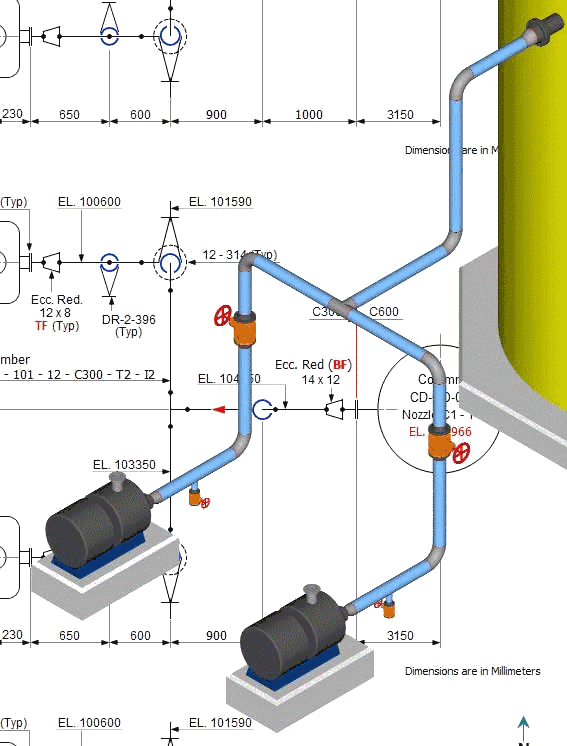Piping Vibration |
Pipe vibrations are vibrations in piping systems caused by the coincidence of the pulsation frequency and the mechanical natural frequency of the pipes, which can lead to resonance conditions.
It is often exacerbated by weak pipeline supports and can be reduced by methods such as adding damping or reinforcing supports.
Possible sources of piping vibration
Vibrations in the pipelines of process installations can pose a significant risk to the integrity and safety of assets. This is often the result of flow-induced vibrations (FIV) and acoustic-induced vibrations (AIV) and is related to the flow of the main process fluid through the piping system.
Other possible sources of vibration in pipes are:
- Equipment such as compressors and pumps generates mechanical forces, which cause vibrations in the pipes.
- High-frequency acoustic vibrations caused by high pressure cause vibrations in the pipes.
- Flow-induced pressure pulsations related to the pipe configuration and other components and characteristics in the flow.
- Fluctuations, water hammer, and momentum changes caused by the sudden closure of the valve, which can also lead to vibrations in the pipes.
- Valve configuration and operation.
- The strong pressure drop, which is often localised, causes cavitation or the collapse of vapour bubbles. This leads to vibrations in the pipes and ultimately to damage to the system.
Most failures in piping systems are caused by connections with small bores. Some reasons for this are:
- When large pipes are not supported.
- When inspections and maintenance for vibrations in pipes are not carried out on time.
- When there are multiple bends, other branches, and tensions in the fluid flow.
For a smoothly functioning piping system without unwanted vibrations, you must eliminate unnecessary bends and branches in a pipeline; they must not resonate mechanically with the excitation forces of the piping system.
Flow induced vibration
Flow-induced vibrations are the result of turbulence in the process fluid, which occurs due to large flow interruptions such as bends, T-pieces, partially closed valves, and connections with small bores.
The high levels of broadband kinetic energy created downstream of these sources are concentrated at low frequencies, generally less than 100 Hz, and can lead to excitation of vibration modes in the pipelines and connected equipment.
The extent of this problem depends on the design of the pipelines, the configuration and stiffness of the support, the operation of the valves, and other related factors that determine the severity of the resulting vibrations.
Risks related to FIV can be managed through screening activities to identify pipeline sections of concern, vibration monitoring and investigation of identified issues, and development of targeted modifications to operating parameters, pipeline configuration, and supports.
Acoustic induced vibration
A relief or control valve in gas systems or other pressure-reducing equipment can generate high levels of high-frequency acoustic energy, an effect commonly referred to as acoustically induced vibration.
In addition to the high noise levels generated outside the pipelines, this excitation can result in high-frequency vibrations of the pipe wall, with the possibility of high dynamic stresses at welded components such as supports and connections with small bores.
This can lead to the possibility of fatigue cracks within a relatively short period of time.
Assessment of the risks associated with AIV can be performed by pressure-reducing devices in gas systems, such as control valves, pressure relief valves, and blow-off valves, to screen for this failure mechanism.
By predicting the acoustic noise generated downstream and estimating the risk of pipeline failure.
Detailed investigation and development of solutions would then be carried out for sections considered to be at risk.
In summary
Vibrations are an unavoidable aspect of pipeline system design, often caused by various factors that can significantly affect both onshore and offshore installations. Vibrations in pipelines that lead to damage and failure of the entire pipeline system must be repaired or replaced as quickly as possible.
Conducting risk-based assessments is one of the most effective and efficient ways to identify, evaluate, and mitigate vibration and fatigue-related hazards. However, modifications to reduce pipeline vibration must also take differential thermal expansion into account to maintain system integrity. Since stress analysis of pipelines and vibration audits may have conflicting requirements, achieving the right balance is essential to prevent stress failures.
References..
www.dnv.com/services
www.technomaxme.com
Related Post(s)

Scope, codes, standards and references, General and specific requirements, Abbreviations for piping specifications, Valve tag numbering, Standard installation detail - Utility Station...